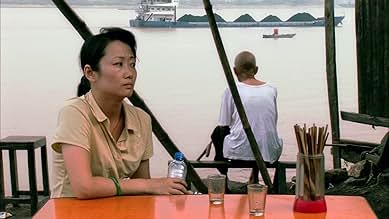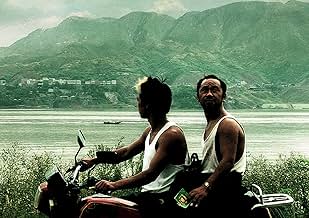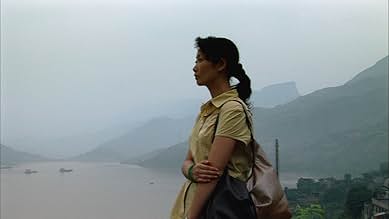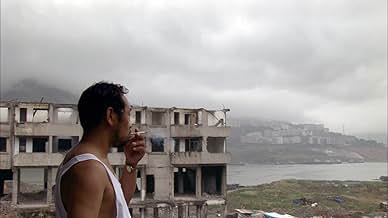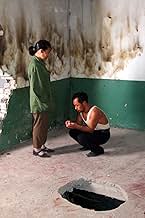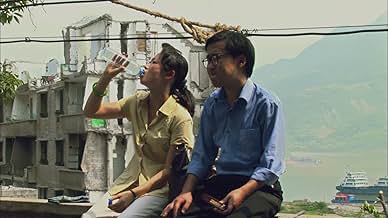IMDb RATING
7.3/10
7.8K
YOUR RATING
A town in Fengjie county is gradually being demolished and flooded to make way for the Three Gorges Dam. A man and woman visit the town to locate their estranged spouses, and become witness ... Read allA town in Fengjie county is gradually being demolished and flooded to make way for the Three Gorges Dam. A man and woman visit the town to locate their estranged spouses, and become witness to the societal changes.A town in Fengjie county is gradually being demolished and flooded to make way for the Three Gorges Dam. A man and woman visit the town to locate their estranged spouses, and become witness to the societal changes.
- Awards
- 15 wins & 14 nominations total
- Director
- Writers
- All cast & crew
- Production, box office & more at IMDbPro
Featured reviews
The comment which was written before mine gives a great and brilliant explanation of the social problems and facts that involves this film, so I am not going to repeat it. I prefer to talk about another one of the most relevant aspects of this movie: the photography, magisterially directed by Yu Likwai. Sometimes one can have the impression to be watching a photo album, further than a movie. There are no bad or ugly photo-grams in this film. Every image contains a really fine sense of photography as an art, including superb landscapes, exiting colors, and intelligent compositions with everything and everybody in the right place, without unaesthetic gaps. A pleasure for eyes and soul.
10enzino-1
Known previously as a documentary, and not as a romance, "Sanxia Haoren" ("Still Life") was the surprise and last film in Venice Festival (Italy) and not even the first one film of the young maker (he already had another movie in competition). Mr Jia shows us China just as it is nowadays. Not the power of huge works, or the beautiful scenery, just as the Dam on the Yangsi River nearby, but simple Chinese people, with simple problems, that do not know nothing such happiness (yet). It's heartbreaking, it's wonderfully filmed, it's like a superb painting. A simple masterpiece (and not only a Golden Lion). The surprise at Venice's Mostra. Catherine Deneuve, the French president of the jury of Venice, was very moved by Jia's work, the story told and the emotion of that film.
Reviewed at the North American premiere screening Tues. Sept. 12, 2006 at the Varsity 8 Theatre during the Toronto International Film Festival (TIFF).
I was lucky enough to be at TIFF screenings on Monday when it was announced that Sanxia Haoren was going to have a special one-time screening as a last minute addition to the Visions programme of TIFF 2006. I think the online tickets went fairly quickly and the theatre was packed with a considerable overflow of film writers & critics who had been unable to squeeze into the industry screening.
Sanxia Haoren has been given the title Still Life for international release, but the original Chinese title would seem to translate simply as Three Gorges Good People and it is in the vicinity of the dam's construction and the city demolitions and the people displacement entailed by it, that the film takes place. The film has a bookend plot of a miner Han Sanming (character's and actor's names are identical) who comes to the town of Fengjie to search for his estranged wife and child. The centrepiece story is that of a nurse named Shen Hong who is searching for her missing husband.
The dour faced Han Sanming is initially a cause of concern as it seems at the very start he is going to be swindled by tricksters on the river ferry but he soon shows that he can hold his own. We then think he is going to conned by a sarcastic motorcycle taxi driver who takes him to the location of his supposed house only for him to find it is now submerged under water. Things soon settle down for Han though as he finds lodging in a boarding house and work as a house demolition man on a crew with a brash young man who seems to have learned all his life lessons from the movies of Chow Yun Fat. Various humorous interludes (such as a young boy who sneaks cigarettes and roams around singing overly romantic songs which usually degenerate into an off-key screech by their end) and certain magic sequences (which I won't spoil) serve to bring comedy and wonder along the way. Several times the screen is seemingly chapter titled with the words "cigarette", "liquor", "tea" and "toffee", when these items occur during the plot, and any other meaning to this device eluded me. The journey of Shen Hong is similarly full of encounters with different characters on the way. I don't think the two stories actually intersected, but I may have been somewhat tired at this mid-way mark of TIFF as this screening went from 10:30 pm to 12:30 am.
The impression that the actors were perhaps simply playing versions of themselves was reinforced later in the week when I also caught the same director's documentary "Dong" which follows painter Liu Xiao-dong around locations at the Three Gorges Dam and it turned out that Han Sanming was actually one of the sturdy workmen that painter Liu was using for his models in a large multi-paneled painting of men. A blond-dye haired motorcycle taxi driver of Still Life makes a cameo appearance in Dong as well.
I found both of these films equally absorbing as they told stories of regular people in somewhat extreme life-changing situations and also that the 2 films complemented each other in a symbiotic way. Seeing one will enhance your appreciation of the other and vice versa. Both films are very deliberately paced but very lyrical and if you have an appreciation for slower paced film they are very rewarding. Also, if you did not have any concept of the magnitude of what is going on in the Three Gorges area, these films will give you a first hand view.
The director Jia Zhang-ke was not in attendance for the North American premiere, as he presumably was still in Venice celebrating his win of the Golden Lion for this film and 2 awards for the documentary.
I was lucky enough to be at TIFF screenings on Monday when it was announced that Sanxia Haoren was going to have a special one-time screening as a last minute addition to the Visions programme of TIFF 2006. I think the online tickets went fairly quickly and the theatre was packed with a considerable overflow of film writers & critics who had been unable to squeeze into the industry screening.
Sanxia Haoren has been given the title Still Life for international release, but the original Chinese title would seem to translate simply as Three Gorges Good People and it is in the vicinity of the dam's construction and the city demolitions and the people displacement entailed by it, that the film takes place. The film has a bookend plot of a miner Han Sanming (character's and actor's names are identical) who comes to the town of Fengjie to search for his estranged wife and child. The centrepiece story is that of a nurse named Shen Hong who is searching for her missing husband.
The dour faced Han Sanming is initially a cause of concern as it seems at the very start he is going to be swindled by tricksters on the river ferry but he soon shows that he can hold his own. We then think he is going to conned by a sarcastic motorcycle taxi driver who takes him to the location of his supposed house only for him to find it is now submerged under water. Things soon settle down for Han though as he finds lodging in a boarding house and work as a house demolition man on a crew with a brash young man who seems to have learned all his life lessons from the movies of Chow Yun Fat. Various humorous interludes (such as a young boy who sneaks cigarettes and roams around singing overly romantic songs which usually degenerate into an off-key screech by their end) and certain magic sequences (which I won't spoil) serve to bring comedy and wonder along the way. Several times the screen is seemingly chapter titled with the words "cigarette", "liquor", "tea" and "toffee", when these items occur during the plot, and any other meaning to this device eluded me. The journey of Shen Hong is similarly full of encounters with different characters on the way. I don't think the two stories actually intersected, but I may have been somewhat tired at this mid-way mark of TIFF as this screening went from 10:30 pm to 12:30 am.
The impression that the actors were perhaps simply playing versions of themselves was reinforced later in the week when I also caught the same director's documentary "Dong" which follows painter Liu Xiao-dong around locations at the Three Gorges Dam and it turned out that Han Sanming was actually one of the sturdy workmen that painter Liu was using for his models in a large multi-paneled painting of men. A blond-dye haired motorcycle taxi driver of Still Life makes a cameo appearance in Dong as well.
I found both of these films equally absorbing as they told stories of regular people in somewhat extreme life-changing situations and also that the 2 films complemented each other in a symbiotic way. Seeing one will enhance your appreciation of the other and vice versa. Both films are very deliberately paced but very lyrical and if you have an appreciation for slower paced film they are very rewarding. Also, if you did not have any concept of the magnitude of what is going on in the Three Gorges area, these films will give you a first hand view.
The director Jia Zhang-ke was not in attendance for the North American premiere, as he presumably was still in Venice celebrating his win of the Golden Lion for this film and 2 awards for the documentary.
Though perhaps 'Still Life'/'Sanxia haoren' (the Variety reviewer thought so) is primarily for the Jia devotee or the festival-goer (it's already been awarded the Golden Lion at Venice) and certainly it's totally noncommercial, it's a lovely, hypnotic piece of work, another haunting picture of the vast creation, disruption, destruction that is modern China from that country's most exciting and original younger-generation filmmaker.
There are layers of irony in the title, because in the incredibly turbulent, ceaselessly active events on screen in this world of life that is anything but "still," the most amazing images slip by without comment. A construction boss on a rampart one evening cell-phones a technician and says, "The VIP's are here. Why aren't the lights on? I'll count to three; then turn on. One, two, three. . ." and a huge bridge and arch are suddenly illuminated behind him. One of the two estranged couples the film follows to tentative reunions is talking with a vast city behind them and in the background a big skyscraper suddenly, silently collapses. There is no comment. It just miraculously happens. In the final shot, amid the debris of the Three Gorges where the world's largest dam will eventually displace 1.4 million people, Han Sanming (non-actor Han Sanming's actual name), a mine worker who's come to find his wife and daughter, who left him sixteen years ago, stands looking out at the urban landscape and a trapeze artist is quietly walking across a tightrope between tall buildings. Again, no comment.
Han Sanming can't find his wife right away and her brother doesn't trust him at first, so he stays for months, working with the brother in demolition. A perky young fellow, who quotes John Wu star Chow Yun Fat and imitates Hong Kong gangster gestures, befriends Han Sanming and they put each other's numbers in their cell phones--a contemporary pledge of solidarity that has a sad sequel later. The young fellow, who could easily have been one of the lost, hopeful young men in Jia's 2002 Unknown Pleasures, is lost in a demolition accident and gets a sea burial like the one accorded to Johnny Depp's character in Jim Jarmusch's Dead Man.
Focused on the displacement of people for a vast industrial and engineering project, Still Life also contrasts classes--the humble working-class stiff who can make 50 yuan a day pulling down walls or 200 going down in a coal mine not knowing if he'll come back out, versus the handsome lady, Shen Hong (Zhao Tao) whose estranged building magnate husband she wants to divorce because she's found a younger man. She has options; Han Sanming is simply drifting and lonely. And in the background for both, though, is the enormous turbulence and activity in which we see both protagonists as tiny helpless figures, their own lives indeed "still life" by comparison.
There's another unexpected, astonishing sequence of a fat rock singer, naked from the waist up like most of the Three Gorges demolition workers Han Sanming encounters and drenched in sweat. He sings of nostalgia for his youth, a time when everybody was happy , and old men in the audience shed tears while garish go-go girls gyrate: where does this fit in? This is another symbol of social upheaval. But what is really happening? Won't Chinese society have to return to its heritage of Mao and the Eighties aftermath chronicled in another of Jia's unwieldy masterpieces, the 2000 Platform? Perhaps the titles Still Life ironically points to the way people are frozen in isolation (broken couples, estranged children) and unhappiness (or quiet desperation) in a China that all the rampant economic progress both masks and perpetuates.
After his colorful land pointed but somewhat leaden 2004 The World/Shijie Jia Zhang-Ke has shown again as in Platform and Unknown Pleasures that he can touch and astonish. The human events are dwarfed by capitalist Progress in the new China, but people (after all, they are a zillion of them there) are still very much in the foreground. \Still Life is an impressive, organic-feeling movie that refers to Jia's earlier films but, extraordinarily, seems to bring together both post-war Italian neo-realism and the desolate urban landscapes of Michelangelo Antonioni.
Seen in Paris, October 21, 2007 at the MK2 Hautefeuille.
There are layers of irony in the title, because in the incredibly turbulent, ceaselessly active events on screen in this world of life that is anything but "still," the most amazing images slip by without comment. A construction boss on a rampart one evening cell-phones a technician and says, "The VIP's are here. Why aren't the lights on? I'll count to three; then turn on. One, two, three. . ." and a huge bridge and arch are suddenly illuminated behind him. One of the two estranged couples the film follows to tentative reunions is talking with a vast city behind them and in the background a big skyscraper suddenly, silently collapses. There is no comment. It just miraculously happens. In the final shot, amid the debris of the Three Gorges where the world's largest dam will eventually displace 1.4 million people, Han Sanming (non-actor Han Sanming's actual name), a mine worker who's come to find his wife and daughter, who left him sixteen years ago, stands looking out at the urban landscape and a trapeze artist is quietly walking across a tightrope between tall buildings. Again, no comment.
Han Sanming can't find his wife right away and her brother doesn't trust him at first, so he stays for months, working with the brother in demolition. A perky young fellow, who quotes John Wu star Chow Yun Fat and imitates Hong Kong gangster gestures, befriends Han Sanming and they put each other's numbers in their cell phones--a contemporary pledge of solidarity that has a sad sequel later. The young fellow, who could easily have been one of the lost, hopeful young men in Jia's 2002 Unknown Pleasures, is lost in a demolition accident and gets a sea burial like the one accorded to Johnny Depp's character in Jim Jarmusch's Dead Man.
Focused on the displacement of people for a vast industrial and engineering project, Still Life also contrasts classes--the humble working-class stiff who can make 50 yuan a day pulling down walls or 200 going down in a coal mine not knowing if he'll come back out, versus the handsome lady, Shen Hong (Zhao Tao) whose estranged building magnate husband she wants to divorce because she's found a younger man. She has options; Han Sanming is simply drifting and lonely. And in the background for both, though, is the enormous turbulence and activity in which we see both protagonists as tiny helpless figures, their own lives indeed "still life" by comparison.
There's another unexpected, astonishing sequence of a fat rock singer, naked from the waist up like most of the Three Gorges demolition workers Han Sanming encounters and drenched in sweat. He sings of nostalgia for his youth, a time when everybody was happy , and old men in the audience shed tears while garish go-go girls gyrate: where does this fit in? This is another symbol of social upheaval. But what is really happening? Won't Chinese society have to return to its heritage of Mao and the Eighties aftermath chronicled in another of Jia's unwieldy masterpieces, the 2000 Platform? Perhaps the titles Still Life ironically points to the way people are frozen in isolation (broken couples, estranged children) and unhappiness (or quiet desperation) in a China that all the rampant economic progress both masks and perpetuates.
After his colorful land pointed but somewhat leaden 2004 The World/Shijie Jia Zhang-Ke has shown again as in Platform and Unknown Pleasures that he can touch and astonish. The human events are dwarfed by capitalist Progress in the new China, but people (after all, they are a zillion of them there) are still very much in the foreground. \Still Life is an impressive, organic-feeling movie that refers to Jia's earlier films but, extraordinarily, seems to bring together both post-war Italian neo-realism and the desolate urban landscapes of Michelangelo Antonioni.
Seen in Paris, October 21, 2007 at the MK2 Hautefeuille.
I've seen lots of presentations by businesspeople and academics about Chinese industry, development, social problems, politics, progress, environmental disasters, etc. etc. I've never seen anything like this. It's China on the ground - actually a town about to be submerged by the Three Gorgest Dam project. The title translation of "Three Gorges Good People" is right - these are ordinary folks who endure, persist, help each other out, etc. in a mixed landscape of natural beauty, building, poverty, and destruction that has to be seen to be understood. The story of the dam shapes everybody's life without actually determining or washing them out. Definitely try to see this if you have any interest at all in China today.
Did you know
- TriviaRanked second in French film magazine Cahiers du cinéma's top 10 list of the best pictures of 2007, tied with Inland Empire (2006) and Boulevard de la mort (2007).
- ConnectionsFeatures Le syndicat du crime (1986)
- How long is Still Life?Powered by Alexa
Details
Box office
- Budget
- CN¥10,000,000 (estimated)
- Gross US & Canada
- $76,983
- Opening weekend US & Canada
- $12,744
- Jan 20, 2008
- Gross worldwide
- $2,504,465
- Runtime
- 1h 51m(111 min)
- Color
- Sound mix
- Aspect ratio
- 1.78 : 1
Contribute to this page
Suggest an edit or add missing content



